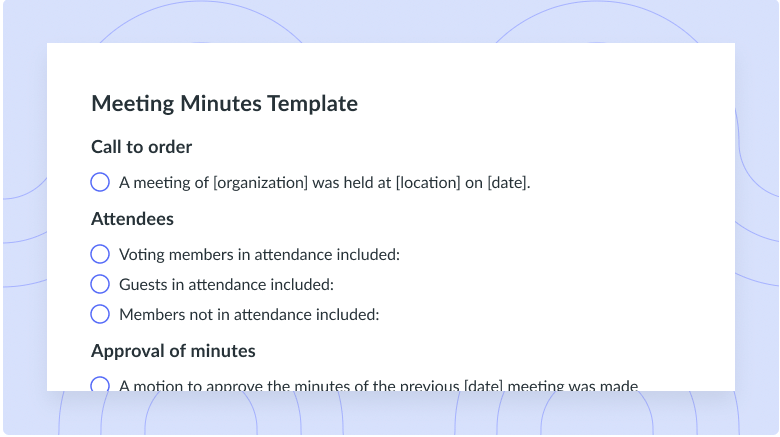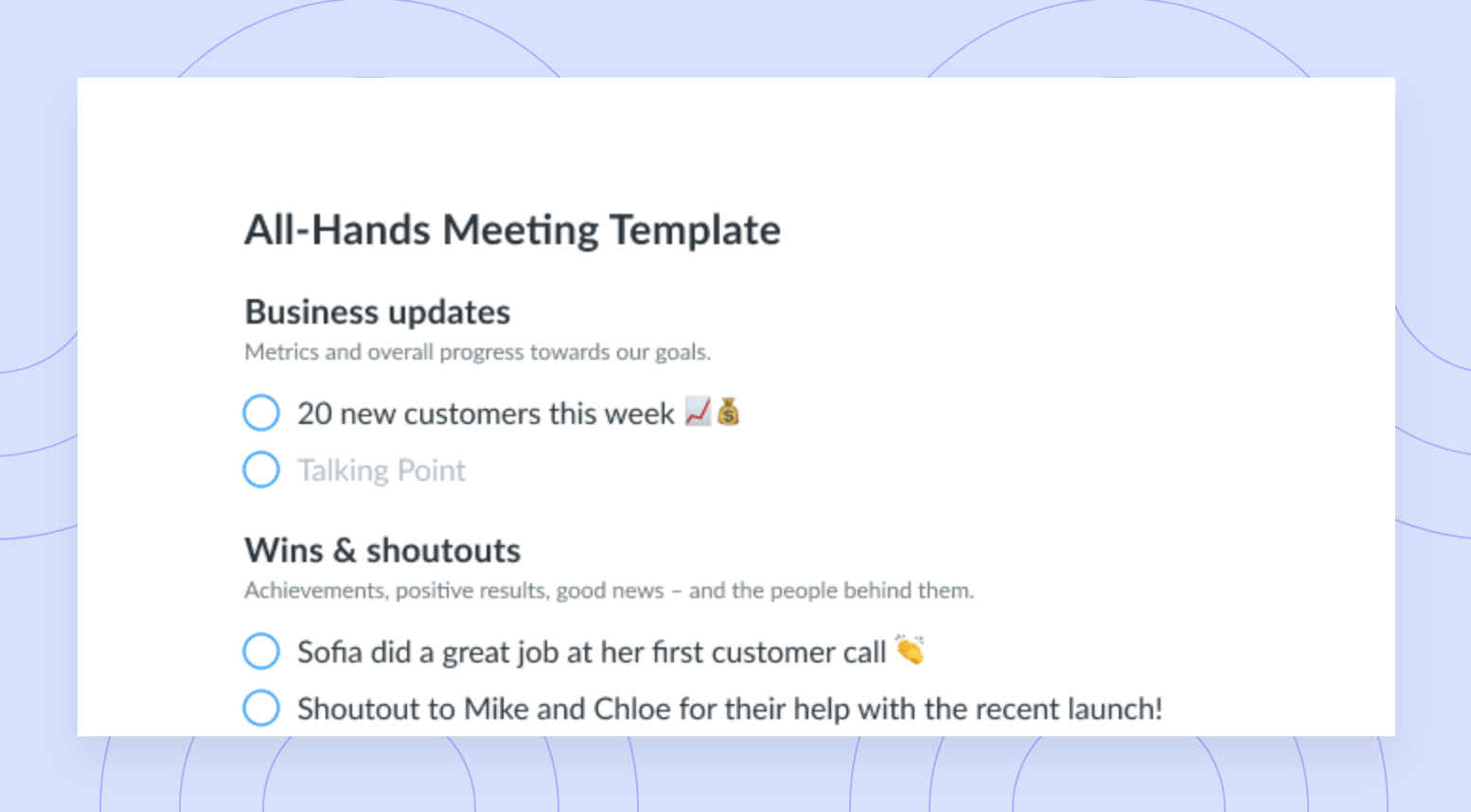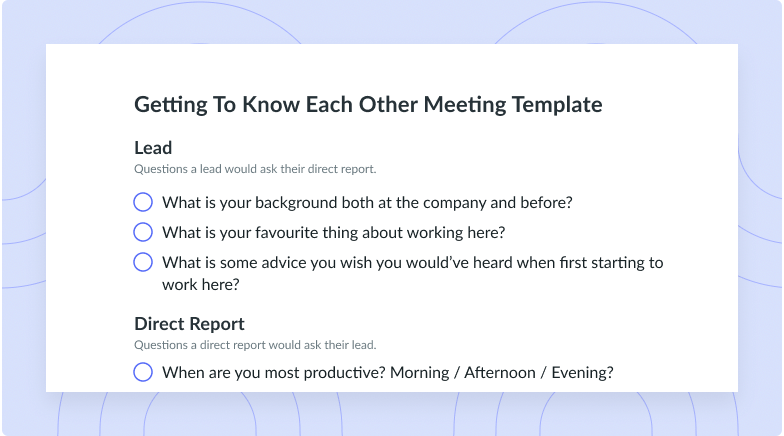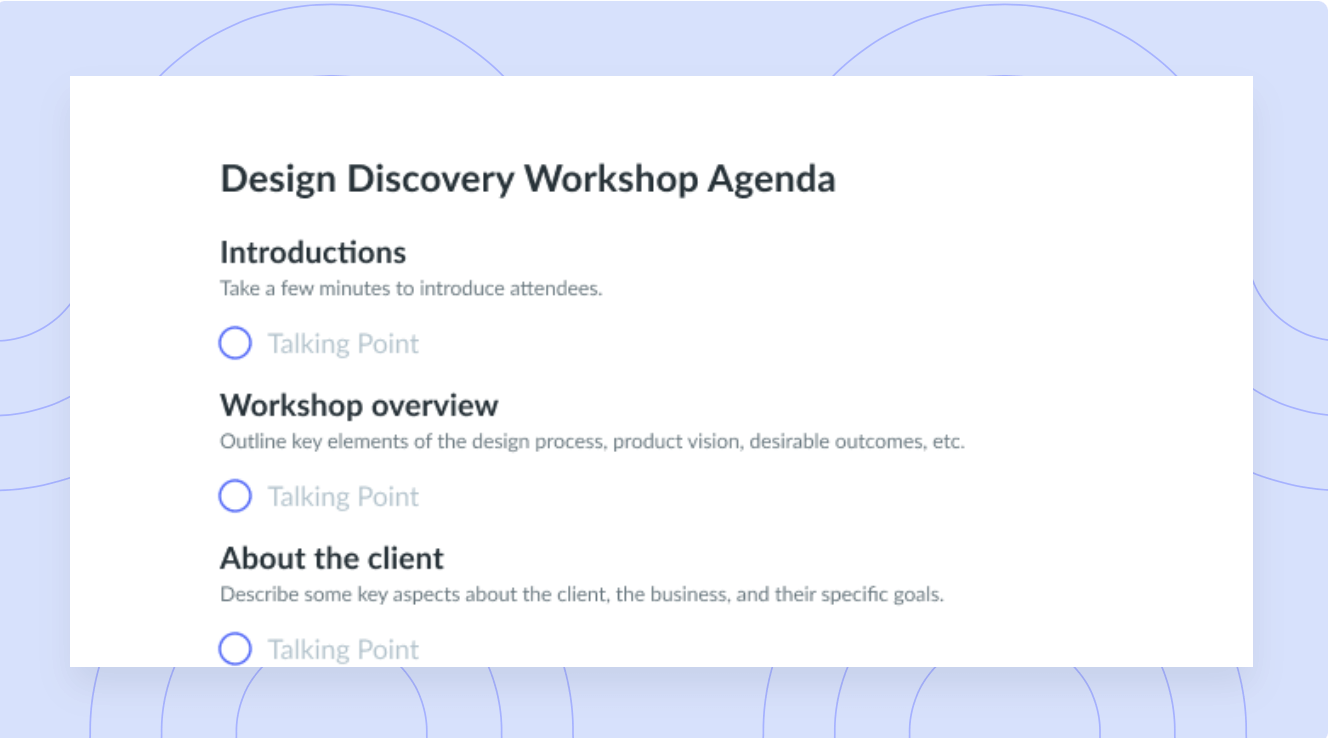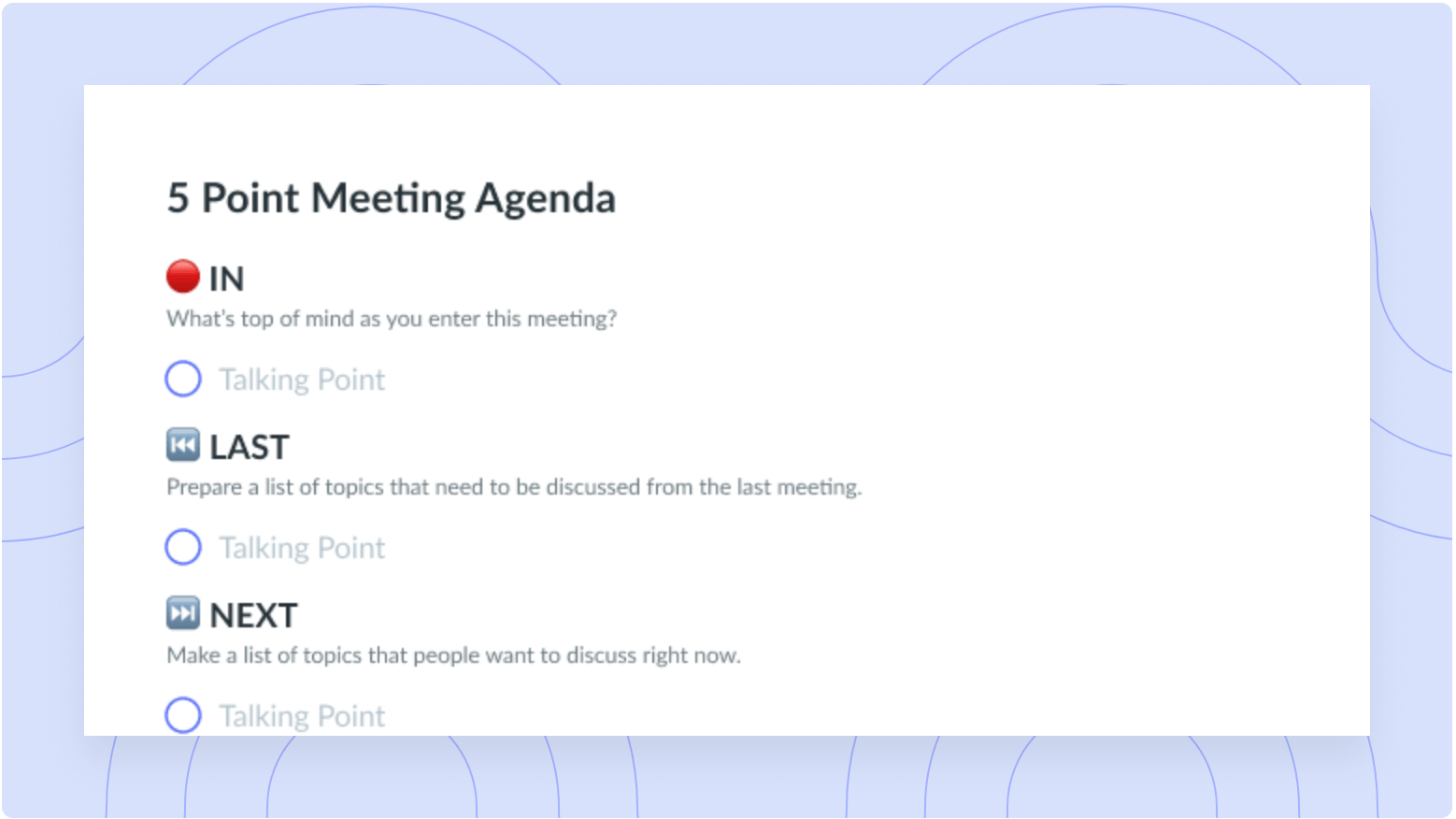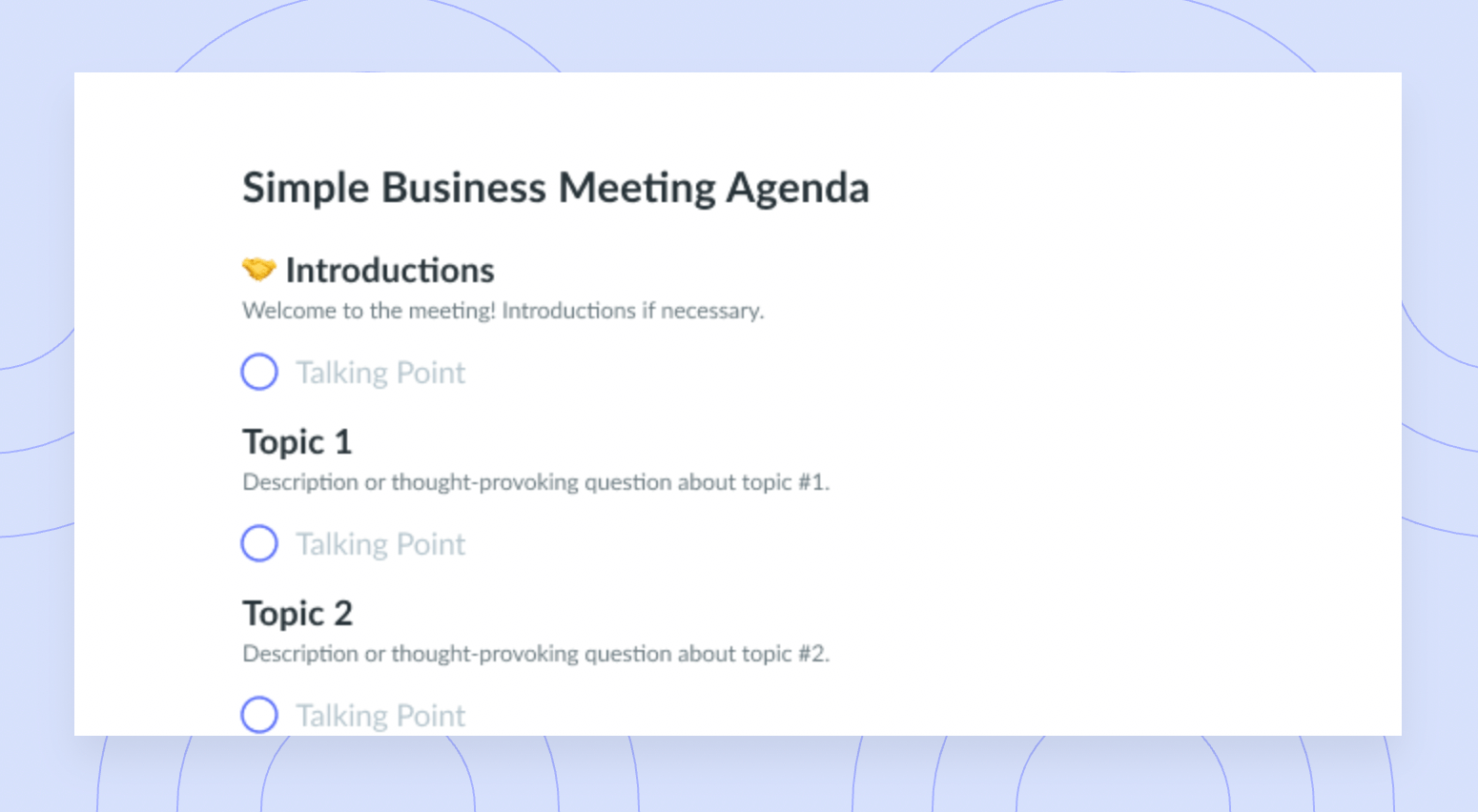How to Stop Meeting Madness in 8 Easy Steps
Meetings aren’t as productive when they happen too often – that’s how your team’s productivity starts to fall behind. Here's how to avoid meeting madness.
Good meetings get your team on the same page and help everyone solve problems together and bond more closely. However, it’s possible to have too much of a good thing. Namely, holding too many meetings can lead to diminishing returns. There’s a name for this effect: “meeting madness.” It’s exactly as unpleasant as it sounds, but you can easily avoid it. Here’s how.
- What is meeting madness?
- How to stop meeting madness in 8 steps
- How do good and bad meetings differ?
- Virtual meetings and meeting madness
- How can it affect your wellness and productivity?
What is meeting madness?
Meeting madness can happen when you schedule an excessive number of meetings. We’re not talking a few per week – we’re talking so many meetings that it guts employee morale and productivity.
Often, meeting madness also means that your meetings are poorly structured or lack an agenda and a clear purpose. These meetings waste precious time that employees can spend on…well, anything else. That’s why meeting madness can have long-term repercussions including lower employee happiness, higher turnover rates, and a truly unmotivated team.

Delightful meetings
Stop the madness by creating collaborative meeting agendas where everyone can contribute their talking points and have productive meetings with a tool like Fellow.
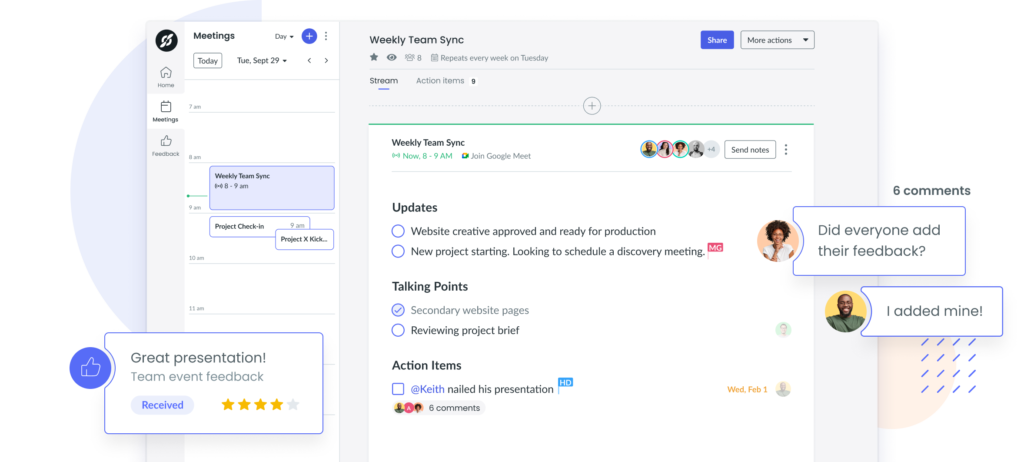
How to stop meeting madness in 8 steps
Knowing why meeting madness is bad is only half the battle. You also need to break yourself out of your bad meeting habits – and that takes work. You can get started with the below techniques to hold more productive, meaningful meetings. Goodbye meeting madness, hello great meetings!
- Be on time
- Stay positive during meetings
- Start with some ice breakers
- Set meeting rules
- Follow your meeting rules
- Be a role model
- Ask for feedback after meetings
- Prepare a meeting agenda
1 Be on time
Good meetings respect everyone’s time. Not starting on time disrupts that goal. Starting a few minutes late may seem like a minor issue, but the long-term productivity loss can really add up. And good luck preventing resentment from building toward the one team member who’s always late. That resentment might be a bit justified – some people find lateness super rude and disrespectful – but it’s nowhere close to healthy. If nothing changes, tensions can flare and cause big-time disagreements. Avoid that!
Commit yourself to starting your meetings at a set time whether or not everyone has arrived. This way, even if people show up late, everyone who did show up on time feels like you’re respecting their schedules. Of course, a late attendee’s arrival can disrupt the ongoing conversation, but starting without them is better than sitting around and waiting. So inform the participants that the meeting will absolutely start on time. Better yet, ask them to arrive five minutes early if possible (or enter your video conference five minutes early).
2 Stay positive during meetings
Picture this: You’re in a meeting full of exhausted, unmotivated, uninterested people. How do you think that meeting will go? You guessed it – badly. You should keep a positive attitude during your meetings to make things more productive and avoid the bad meetings that lead to meeting madness. You should also encourage positivity among everyone in the room – it can spread throughout the room as can negativity. It’s also easier to encourage when your meeting’s purpose and schedule is clear in the first place (more on that later).
3 Start with some ice breakers
Collaborative meetings go better when everyone present trusts one another. Without that trust, employees might not feel comfortable sharing their ideas, meaning your meeting won’t be all it could be. A lighthearted ice breaker can change that. Ice breakers can help everyone feel more at ease and encourage team-building before the meeting formally starts. Effective icebreakers help your team members trust each other and lead to more enjoyable meetings.
4 Set meeting rules
Clearly defined rules can help you set the right tone for your meetings and keep attendees from getting on each others’ nerves. After all, even if your organization is a fun and upbeat place, your employees are still in a professional environment. During meetings, they should act like it.
Meeting rules can also help quell tensions when disagreements pop up. That’s important: Conflicts are somewhat inevitable when a bunch of people debate the best way forward. If these conflicts regularly lead to hostility, meeting madness can result. If you harness these conflicts to come up with great new ideas, meetings can instead be learning opportunities.
5 Follow your meeting rules
It’s one thing to set meeting rules. It’s another to know that your team will actually follow them. That’s easier when you collectively decide how your meetings should proceed – and when you lead by example.
Team members can be more likely to follow your rules when they helped form them and can see you following them. To help emphasize your meeting rules for new attendees, keep them somewhere easily visible. Try printing a poster to hang on the conference room wall or sharing the rules online. Either way, you’ll be keeping your meetings great and thwarting meeting madness.
Setting up your organization’s meeting rules in Fellow is easy. Fellow helps ensure that meeting attendees with 20+ hours worth of meetings per week can still find time to get work done with the Meeting Guidelines feature set. With this feature, when a meeting is being created with an attendee who has 20+ hours of meeting that week, the meeting organizer is automatically reminded that the attendee is already highly booked.
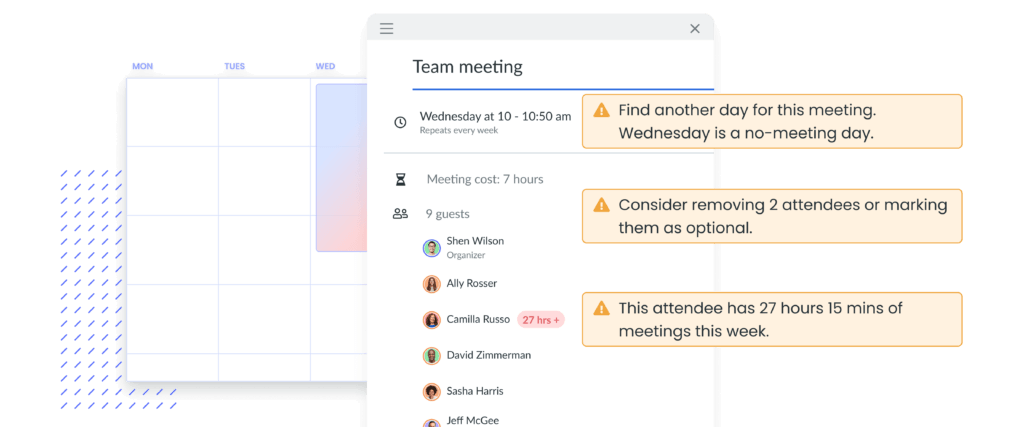
6 Be a role model
This one bears repeating: An enjoyable meeting means leading by example and following your meeting rules. What good are rules if the person who enforces them can’t follow them?
A good rule of thumb is that you get what you give. That’s why you should clearly restate your rules at the start of each meeting. Your rules could include a ban on electronic devices, a guaranteed chance for everyone to speak, and showing up on time. Now here’s the key: You too must turn your phone off, not talk over anyone, and arrive at the meeting on time. Your team might follow suit.
7 Ask for feedback after meetings
Effective meetings can often be even more effective. That’s why you should seek input from the people who matter most: Your team members. They’ll have valuable thoughts on how your meetings affect their workflow and motivation. They should be your first-go to for advice on how to improve your meetings.
Sure, not-quite-positive peer feedback and constructive criticism can be tough to hear at first. Over time, though, you’ll likely see that honest feedback helps you fine-tune and improve your meetings. Additionally, being open to change can show your team that you value their opinions, which in turn can help you build trust. That means your team will feel safer expressing its ideas, leading to better meetings.
8 Prepare a meeting agenda
One of the main traits separating a good meeting from a bad meeting is a clearly defined goal. Without a clear goal, your meetings can waste valuable time and disrupt team members’ normal workdays. The result can be – you guessed it – meeting madness. Preparing and distributing a meeting agenda before your meeting can help you avoid this issue.
A meeting agenda is a document you give to attendees at or (ideally) before a meeting that outlines the goals, speakers, and major talking points. It helps get everyone on the same page from the jump and drives more effective communication and problem-solving.
How do good and bad meetings differ?
Despite the clear problems associated with excess meetings, you might still feel tempted to defend your frequent meetings as a necessary evil. You might do so since you know the benefits of a good meeting and really want to reap those rewards. But can you really reap those rewards if your meetings are bad? Not quite. That’s why you should get to know what makes a meeting good or bad.
The good news is that the differences between productive meetings and draining ones are pretty clear-cut. Good meetings:
- Have a clear, well-defined purpose
- Lead to a collaborative environment where all ideas receive equal consideration
- Move your team closer to your goals in some traceable way
Conversely, bad meetings:
- Often lack an apparent reason or plan
- Include the wrong people to solve the problem
- Don’t lead to any real solutions
- Run for too long or start too late
How do virtual meetings affect meeting madness?
As video conferencing technology has advanced, virtual meetings have become much more prevalent, and for good reason. Run properly, they can allow for tighter agendas, shorter meeting times, and better collaboration with international employees. That said, they’re not immune to meeting madness.
Virtual meetings can sometimes present challenges for collaboration and basic conversation – poor internet connections, choppy audio, that one attendee who’s always off mute. As such, virtual meetings present their own challenges for avoiding meeting madness. And that’s to say nothing of how, behind a video camera or through a phone, employees can more easily disengage from the conversation.
Additionally, a virtual setting can mean fewer restrictions on your meetings, and this looseness can worsen certain meeting problems. For example, it’s easier to invite anyone at all to a virtual meeting, so some managers may invite employees who don’t need to be there. Their presence can needlessly disrupt or prolong certain conversations. Another consequence of this ease of access: Arriving late or leaving early can feel less problematic, even though both can still contribute to meeting madness.
How can meeting madness affect your wellness and productivity?
While meetings often benefit the company as a whole, their psychological effects on your team can’t be overstated. But wait – most meetings can be boiled down to sitting, thinking, and conversing. Is any of that really that stressful? Maybe not at first. But doing it every week for hours on end can negatively impact your employees’ mental health.
For example, if a bad meeting stems from your total lack of a meeting agenda, the participants won’t know what to expect. They might even worry about receiving bad news. They’ll also arrive unprepared for a meaningful conversation and perhaps feel like their time is being wasted. Maybe they won’t feel safe enough to pitch their ideas either. Nothing about this all makes for a healthy, productive work environment.
When employees spend excess meeting time going unheard or unvalued, they can start to dread your meetings. That dread, in turn, can cause long-term, persistent fear and anxiety that hampers your team’s ability to focus on work. Lower job satisfaction is all but sure to result. But you can avoid all these problems.
Meetings can make sense again
Meeting madness can often sneak up on an organization, as negative impacts often take time to stick out. One of the best ways to proactively avoid bad meetings and meeting madness is to clearly state your meetings’ purpose, and Fellow can help. Our user-friendly meeting tools let you set agendas, take real-time notes, and set clear milestones with ease. Say goodbye to meeting madness and hello to your best meetings yet.









